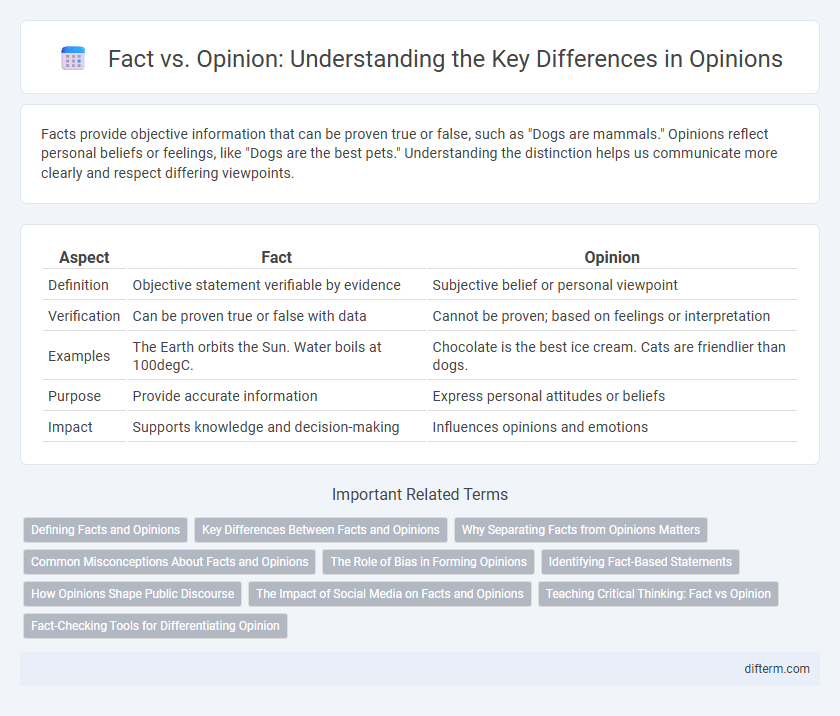Facts provide objective information that can be proven true or false, such as "Dogs are mammals." Opinions reflect personal beliefs or feelings, like "Dogs are the best pets." Understanding the distinction helps us communicate more clearly and respect differing viewpoints.
Table of Comparison
| Aspect | Fact | Opinion |
|---|---|---|
| Definition | Objective statement verifiable by evidence | Subjective belief or personal viewpoint |
| Verification | Can be proven true or false with data | Cannot be proven; based on feelings or interpretation |
| Examples | The Earth orbits the Sun. Water boils at 100degC. | Chocolate is the best ice cream. Cats are friendlier than dogs. |
| Purpose | Provide accurate information | Express personal attitudes or beliefs |
| Impact | Supports knowledge and decision-making | Influences opinions and emotions |
Defining Facts and Opinions
Facts represent objective truths verified through evidence, measurable data, or observable events, while opinions reflect personal beliefs, interpretations, or feelings that cannot be universally proven. Distinguishing facts from opinions is crucial for critical thinking, as facts provide a reliable foundation for analysis, whereas opinions influence perspectives and decision-making. Understanding this difference enhances the ability to evaluate information critically and engage in informed discussions.
Key Differences Between Facts and Opinions
Facts are objective statements that can be verified through evidence, research, or observation, such as "Water boils at 100 degrees Celsius at sea level." Opinions reflect personal beliefs, feelings, or interpretations and cannot be proven true or false, for example, "Chocolate ice cream is the best flavor." Understanding key differences between facts and opinions is essential for critical thinking, effective communication, and evaluating information credibility.
Why Separating Facts from Opinions Matters
Separating facts from opinions is crucial because facts provide verifiable information that forms the foundation of informed decision-making, while opinions reflect personal beliefs or interpretations that can introduce bias. Understanding this distinction helps prevent misinformation and promotes critical thinking by enabling individuals to evaluate evidence objectively. Accurate communication and healthy discourse depend on recognizing when statements are rooted in observable reality versus subjective viewpoints.
Common Misconceptions About Facts and Opinions
Many people mistakenly believe that facts are always indisputable truths, while opinions are simply personal preferences, overlooking that some facts can be context-dependent and subject to interpretation. Confusing opinions presented with factual language often leads to misunderstandings, especially in media and everyday discussions where subjective judgments are framed as objective truths. Recognizing the nuanced differences and the potential for overlap between facts and opinions is essential for critical thinking and informed decision-making.
The Role of Bias in Forming Opinions
Bias significantly influences how individuals interpret facts, often shaping opinions based on personal experiences, beliefs, or emotions rather than objective evidence. Cognitive biases such as confirmation bias lead people to favor information that supports their preexisting views, reinforcing subjective opinions. Recognizing and mitigating these biases is crucial for distinguishing between factual information and opinion-driven perspectives.
Identifying Fact-Based Statements
Fact-based statements rely on verifiable data, objective evidence, and empirical observations that can be confirmed through research or observation. Identifying these statements involves checking for consistency with credible sources, measurable outcomes, and clear definitions free from personal bias. Understanding the distinction between facts and opinions enhances critical thinking and promotes informed decision-making.
How Opinions Shape Public Discourse
Opinions shape public discourse by influencing societal values and guiding policy debates through personal beliefs rather than empirical evidence. While facts provide a foundation for truth, opinions inject diverse perspectives that drive conversations and cultural evolution. The interplay between facts and opinions ultimately shapes public understanding and collective decision-making processes.
The Impact of Social Media on Facts and Opinions
Social media platforms amplify the blurring of facts and opinions by rapidly spreading unverified information, which challenges users' ability to discern truth from bias. Algorithms prioritize engaging content, often promoting sensational opinions over factual accuracy, thus shaping public perception and discourse. This dynamic contributes to echo chambers where opinions are reinforced, diminishing critical evaluation of established facts.
Teaching Critical Thinking: Fact vs Opinion
Teaching critical thinking involves distinguishing between fact and opinion to enhance analytical skills and informed decision-making. Facts are verifiable and objective, while opinions reflect personal beliefs and interpretations, requiring learners to assess evidence critically. Developing the ability to identify these differences strengthens reasoning and promotes intellectual independence in academic and real-world contexts.
Fact-Checking Tools for Differentiating Opinion
Fact-checking tools play a crucial role in distinguishing opinions from factual statements by verifying the accuracy of claims using reliable sources and databases. These tools use algorithms and expert analysis to assess the veracity of information, helping users identify bias, misinformation, and subjective viewpoints. Employing fact-checking platforms like Snopes, FactCheck.org, and PolitiFact enhances critical thinking and promotes informed decision-making in an era of information overload.
Fact vs Opinion Infographic

 difterm.com
difterm.com